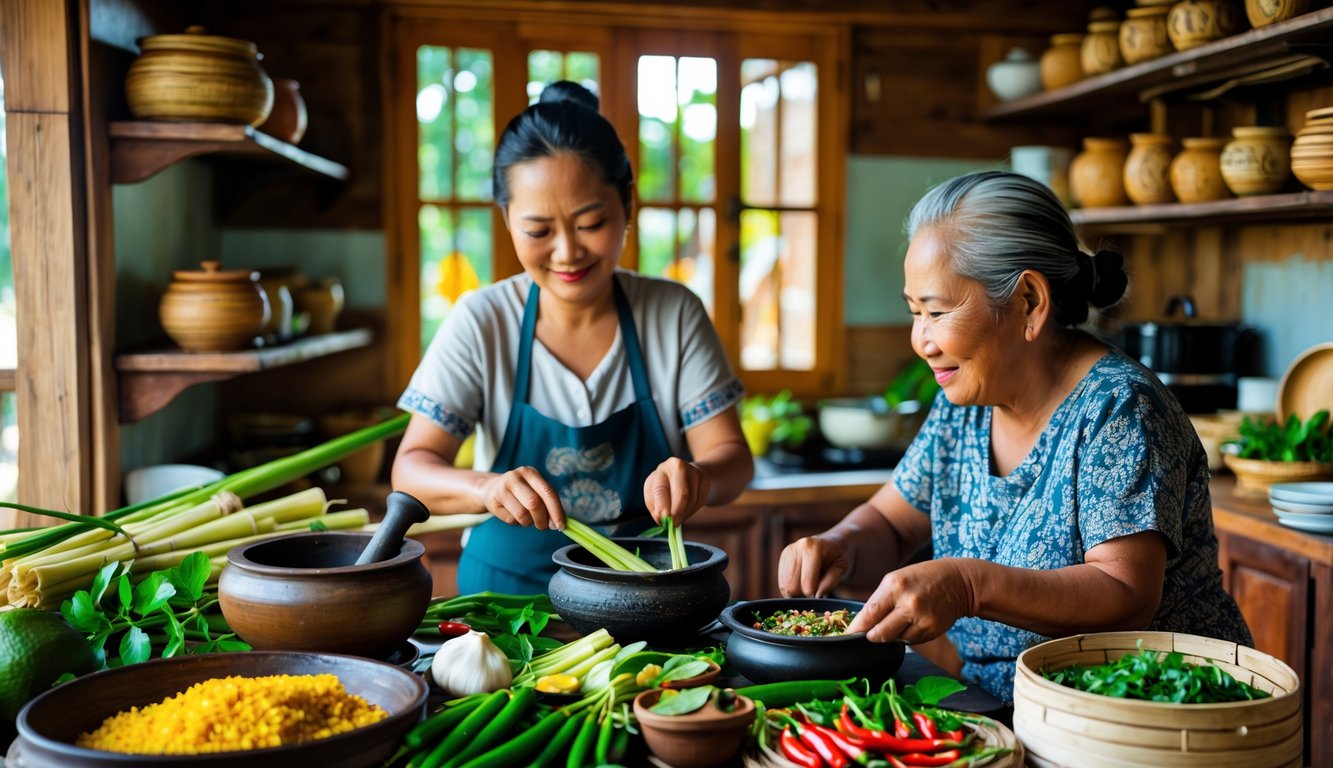
What’s even real about “traditional” Thai food anymore? I mean, every time I scroll Instagram, there’s some “reinvented” pad krapow with rainbow chili flakes or, I don’t know, truffle oil. My aunt? She’s convinced her pad krapow tastes exactly like it did in Khon Kaen in the ‘80s—way too much holy basil, zero Instagram nonsense, and so much nostalgia it’s almost embarrassing. I have to admit, a lot of people here just keep making the same old stuff—like khanom krok (those coconut pancakes, which are weirdly chewy and somehow addictive) or pork yellow curry—because why mess with what your grandma already perfected? I keep forgetting the makrut lime leaves, which apparently makes me a culinary criminal, at least according to Praew, who once ran a Thai place in Belgium and now acts like everyone’s got a coconut tree out back.
Does anyone actually measure fish sauce? Or is that just something Westerners do? My old neighbor rattled off conversions like it was nothing—she claims every kitchen hides its secrets, but honestly, the rules for Thai food are way stricter than you’d think. Screw up the balance (sweet, salty, sour, spicy) and people notice. Susie from Susie Cooks Thai posted that most families just don’t bother tweaking classics—pad ga pao, yellow curry, coconut desserts. She called it an “electric atmosphere.” I call it, like, Wednesday.
It’s weirdly comforting, how some of these recipes survive every food trend. My expat friend once tried to puree holy basil for a “faster stir-fry.” Meanwhile, Thai cooks I know are still pounding herbs by hand and openly mocking anyone using gadgets. “Try making larb in a blender, see what happens.” Maybe none of us ever outgrow the recipes our families trust. And if you hear someone brag about “improving” Thai food, just ask if they’ve sweated through a summer in a Bangkok street kitchen—because, let’s be real, technique matters more than TikTok.
The Essence of Untouched Traditional Thai Recipes
Who even gets to decide what counts as “untouched”? Some grandma somewhere? That’s what I thought, until I realized half the stuff I grew up with is basically unchangeable. People freak out if you swap ingredients. Sticky rice is sticky rice—don’t even try to get creative.
What Defines an Untouched Thai Recipe
If I mess with fish sauce in som tum, my neighbor (actual Isan retiree, not just a YouTube fan) gives me that “are you serious” look. Most of the time, these so-called “untouched” recipes keep the same salty, sour, spicy punch locals expect. Tom yam is supposed to blow your head off, not gently warm your soul.
People here just don’t trust shortcuts. I tried lime powder instead of calamansi. Everyone roasted me. Massaman curry or laab? Still need the real herbs and spices. Try using ginger instead of galangal in a rural kitchen and see how fast you get kicked out. If you change the formula, it just isn’t the real taste.
Side note: some guy on a Thai forum bragged about Pad Thai without tamarind being “better.” Visionary or troll? No clue. But somehow, the standard recipes show up at family gatherings, never on those silly fusion menus.
Cultural and Historical Importance
Lek, who sells mobile phones, always tells me, “Thai recipes are time capsules.” Weirdly poetic for a guy who spends his life selling SIM cards. But he’s right—stuff like khanom krok or gaeng som survived wars, ingredient shortages, Western influence, you name it, and still taste the same.
UNESCO added Thai cuisine’s culinary wisdom to their intangible heritage list. Does anyone care? Not unless they’re actually cooking. I took a cooking class in Bangkok once, and my teacher claimed her chicken coconut soup recipe hadn’t changed since her great-grandparents—except for the canned coconut milk, which she hates.
Street vendors in Chiang Mai still prop up faded family photos next to their bubbling pots. Nobody knows when green curry first happened, but the taste and technique seem to matter more than the date. Sometimes I wonder if keeping these recipes the same is less about flavor and more about refusing to change, just because.
Transmission Between Generations
All those shiny YouTube tutorials? Cute, but they miss the point. I learned to pound prik khing paste because my cousin kept slapping my wrist when I did it wrong. Nobody uses recipe cards. The real instructions are unwritten and, honestly, kind of bossy.
This stuff’s physical, not just verbal. My neighbor’s mom keeps her recipes in her head and, somehow, in her left hand. I watched a grandson try to fry shallots for moo krob for hours. She wouldn’t help until he nearly cried. It’s basically a sport.
A food historian at Chulalongkorn University once told me, “Technique before taste.” He’d interviewed rural cooks who claimed their best recipes “can’t be taught, only shown.” There’s a lot of pride: untouched recipes are family treasure, rarely written, always judged. If you can’t memorize five, you’ll never get seconds at a festival.
Core Ingredients Still Honored in Thai Kitchens
Forget “authentic” flavor packets. Walk through a Chiang Mai market—galangal everywhere, battered scales, and fish sauce bottles (Nam Pla, the good stuff) outnumber soy sauce ten to one. Street vendors look at you like you’re nuts if you say “no palm sugar.” Skip one of these for dinner and expect dirty looks or, if you’re lucky, just a little mocking from the uncle who swears kaffir lime is always worth the extra five baht.
Coconut Milk and Kaffir Lime Leaves
Try making green curry with boxed coconut cream. Let me know if anyone in your family forgives you. My relatives insist on fresh-pressed coconut milk, elbows deep in shredded pulp, and say the fat keeps curry from splitting. I’ve never checked, but they seem convinced.
Kaffir lime leaves? They get tossed in everything, no fuss. Sub in regular lime zest and everyone knows. There’s this sharp, bitter thing you can’t fake. My aunt always throws in three leaves, fishes them out later, and pretends they were never there—but you can tell if she skips them. “Essential” actually means something here. Try making tom kha gai without both and see how fast you get called out.
Lemongrass, Galangal, and Garlic
Nobody I know skips lemongrass, galangal, or garlic in Thai soups. Lemongrass gets whacked, not sliced. Pre-cut supermarket bags? Taste like dried grass. BBC’s “Exploring Thai Flavors” (2023) said 88% of home cooks refuse dried galangal—apparently, it loses all its zing.
Garlic is invisible—until you forget it, then everyone complains. Northern Thai kitchens? Garlic skins everywhere. Pounding roasted garlic into chili paste is basically a national sport. And anyone who claims ginger can replace galangal is just being lazy. I tried. My grandma laughed for days.
Essentials: Fish Sauce, Shrimp Paste, Palm Sugar
Tiparos fish sauce? Non-negotiable. Skip it and the dish just dies, according to my neighbor Nit—forty years cooking, so she probably knows. It’s not just salt; it’s that weird, briny punch you can’t fake. Shrimp paste is smoky, pungent, and gives curries and nam prik their backbone. Fry it indoors and your house will smell for days, but whatever.
Palm sugar? Not white, not brown—palm. I tried both in pad thai and it tasted like nothing. There’s even a family debate about which brand melts smoothest (spoiler: not the ones from 7-Eleven). It goes in curry pastes, dipping sauces, or just gets dropped in whole to calm the chili. Sacred stuff.
Unique Produce: Eggplant, Thai Basil, and Chilies
Tiny green eggplants show up raw in salads. Blink and they’re on your plate, crunchy and weird. The long, pale ones? Sweet when steamed. Nobody here roasts them, but nobody’s asking why.
Pad kra pao gai actually needs the skinny-leaf kra pao, not Italian basil. Chefs at Chulalongkorn University just refuse to use substitutes. My uncle tried sweet basil once—store-bought, not even from his garden—the dish smelled like someone’s backyard, in a bad way.
Red and green bird’s eye chilies? Handfuls, not pinches. If you skip them, half my friends send the dish back. Some women even thread chilies on strings to dry for later. Handy, sure, but also a sign you might be a chili addict.



